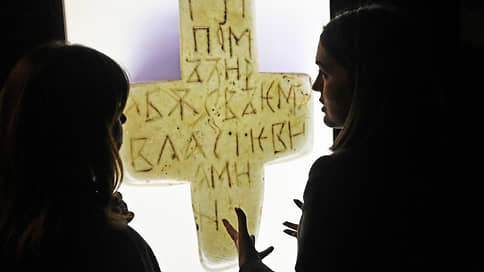Golden Gates to History
[ad_1]

The exhibition “The Grand Duchy. Treasures of the Vladimir-Suzdal land. Hundreds of exhibits from the Vladimir-Suzdal Museum-Reserve, including miraculous icons, fragments of white stone carvings, the “golden gates” of the Suzdal Nativity Cathedral, a whole treasure trove of women’s jewelry, were brought to Moscow on the eve of the millennium of the first annalistic mention of Suzdal, which will be celebrated next year. Tells Igor Grebelnikov.
An exhibition in Moscow of Vladimir-Suzdal antiquities would have been doomed to success even without any round date: in terms of the number of outstanding monuments of architecture and art of medieval Rus’, this is the richest region and one of the most promoted tourist destinations. I recall the exhibition “Holy Rus'”, which was collected in more than twenty Russian museums and shown first in the Louvre (“Kommersant” wrote about it on March 9, 2010), and then in a new version – in the Tretyakov Gallery. One way or another, depending on the audience to which that exhibition addressed, it carried away the story – about the cultural and political involvement of medieval Rus’ in European affairs, about how the arts developed here, about the influence of other cultures on them, and above all Christianity, eastern and western. As then, the exposition is opened by the “golden gates” of the early 13th century from the Nativity Cathedral in Suzdal. They depict 28 scenes from the New Testament and Mother of God cycles, including the first image of the Intercession of the Virgin, using the technique of fire gilding. According to a widespread version, the church began to celebrate the Intercession from the middle of the XII century just in the Vladimir-Suzdal principality at the initiative of Prince Andrei Bogolyubsky. We no longer have anything like the Suzdal “golden gates”, and for their time, their design was a curiosity, rather in the spirit of the Western European tradition than the Byzantine tradition, which was much more common in pre-Mongolian Rus’.
From the theme of cultural exchange with Europe, the influences of Romanesque architecture, which formed the unique style of Vladimir-Suzdal white-stone architecture, the exhibition quickly departs: the “golden gates” are placed in front of a conditional convex apse in the manner of the Royal Gates, next to it on the floor is a giant lantern, already from the beginning of the 17th century. It is from the same Nativity Cathedral and impresses not so much with the sophistication of execution as with the amusingness of the forms – like the cathedral itself, the lantern is crowned with five domes.
During the religious processions, eight people carried a two-meter lantern, but, alas, this fabulous spectacle here has to be imagined surrounded by dark gray false walls. The exposition is decorated in too strict, if not gloomy tones, and the scale of the walls and passages between the halls seems disproportionate to the exhibits: as if you are wandering through a labyrinth, where the sections of the exhibition are named without any special fuss – “Gates”, “Icons”, “Books”, “Treasures ”, “White Stone”, “Tree”. This is all the more annoying if we are not talking about the darkest period of Russian history – about monuments that survived even the Tatar-Mongol yoke.
The Vladimir-Suzdal principality became the most powerful in Rus’, in fact, the basis for the further unification of the Russian lands, revealing, however, in the person of Andrei Bogolyubsky a new type of autocrat ruler, who for centuries came to the taste of the Russian authorities. The exhibition could have paid more attention to the figure of this prince, although his shadow, of course, hovers in the most spectacular sections of the exhibition devoted to icons and white stone architecture. In the “biography” of Andrei Bogolyubsky, canonized by the church already in the time of Peter I, earthly and “heavenly” affairs are linked so cleverly that one is amazed. In 1155, he disobeyed his father Yuri Dolgoruky, who occupied Kyiv, refused to rule at his side in Vyshgorod, and, having taken the miraculous icon of the Mother of God, which was already then especially revered, in a convent, he went with her to Rostov. On the way, an incident happened: the horses stopped near the banks of the Klyazma and did not move any further, in response to the pleas of the prince, the Mother of God appeared and ordered that the icon with her image be taken to Vladimir, which he did. Now it is one of the most revered shrines of the Orthodox Church – the Vladimir Icon of the Mother of God. The exhibition has a list of her supposed authorship by Andrei Rublev of the late 14th – early 15th century. On the place where the Mother of God appeared to the prince, he soon rebuilt his residence Bogolyubovo, in its place later a monastery arose, and a little further from the palace – the Church of the Intercession on the Nerl, a masterpiece of white stone architecture. So he approved a new religious ideology – the cult of the Virgin.
The largest and only bright hall is dedicated to the white-stone architecture of the Vladimir-Suzdal principality: there you can see in detail the carved details of the facades of the cathedrals of Vladimir, Suzdal, Bogolyubovo – both original fragments dating back to the time of their buildings, and casts. Another chance, along with carved smiling lions, leopards, human dragons, griffins, female masks, to imbue that era and the fearlessness of that principality, eager for everything new, able to decorate its cities and redraw borders.
[ad_2]
Source link






